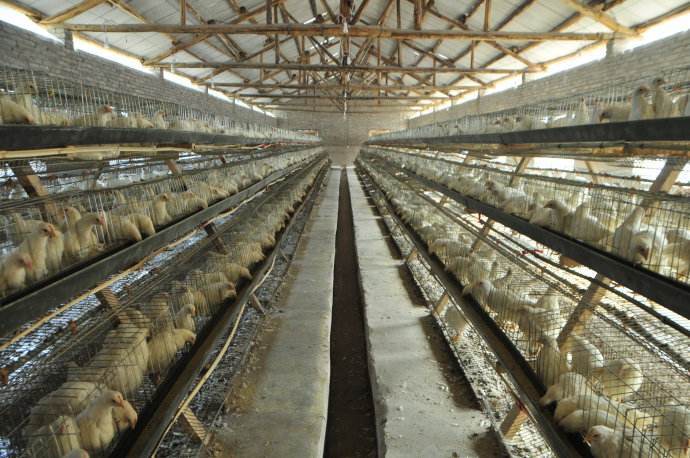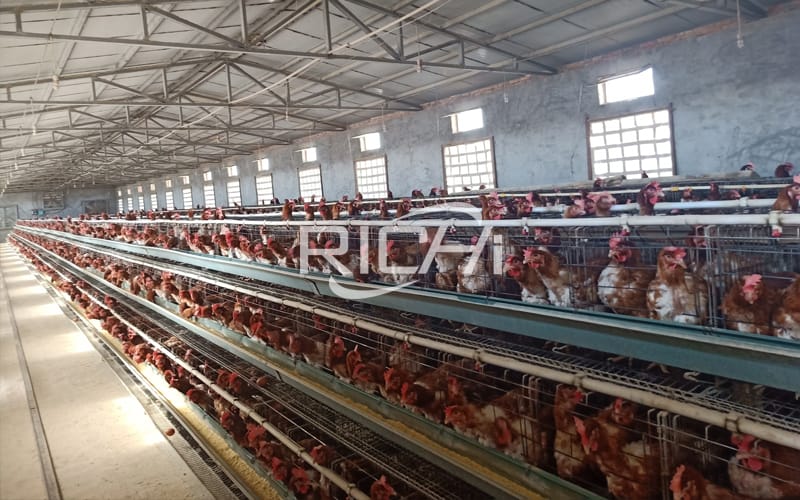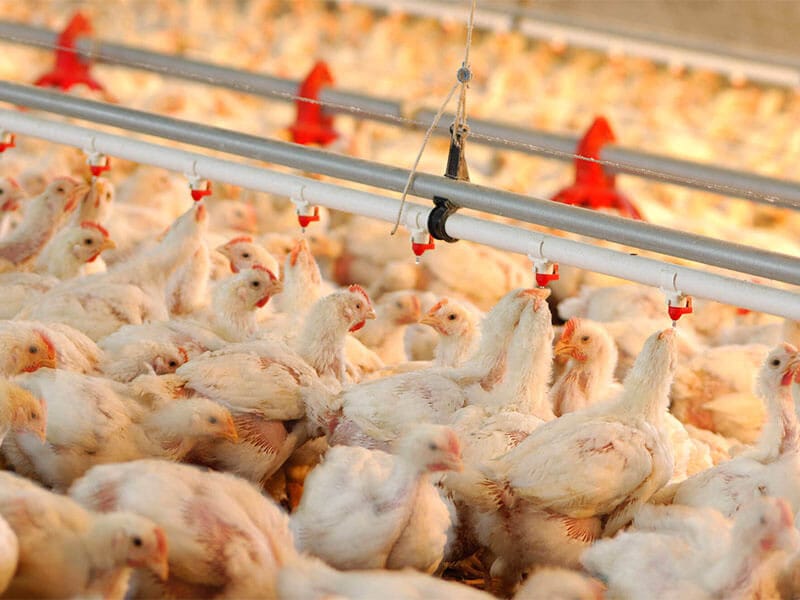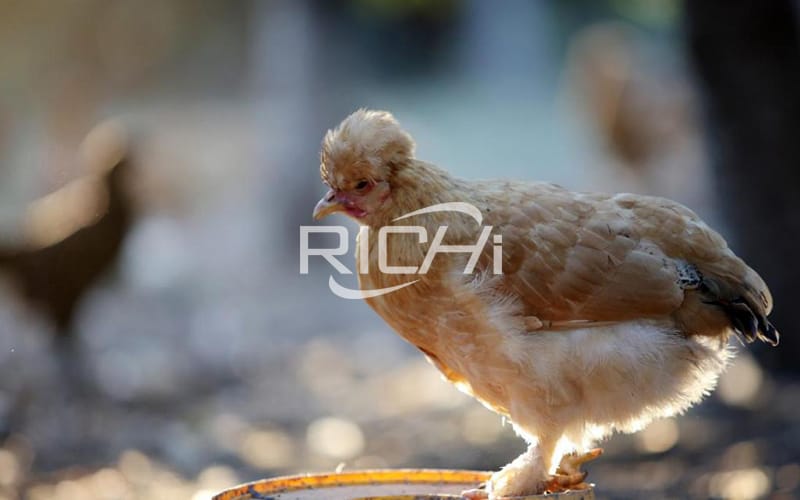Modern chicken house design and chicken farm ventilation management

1. The construction of chicken coop:
(1) Strictly arrange the brooding, brooding, and laying houses in order from upwind to downwind;
(2) Build chicken coops in dry terrain;
(3) The chicken house should be gradually increased by 5-10 cm from the direction of the dominant wind from front to back (to prevent the front from blocking the back);
(4) The space between chicken houses is not less than the height of 3 houses (the highest point) for open houses and not lower than 2-2.5 houses for closed houses;
(5) The orientation of the chicken coop; do not easily build chicken coops on the north-south vertical axis. In the north, the south is the main choice, which can be deflected 15 degrees to the east or west. It is better to deflect from the south to the east. The degree of freedom for deflection in the north can be greater. The Beijing area can be deflected 45 degrees east or west, preferably 45 degrees south to east.
(6) The height is reasonable: the brooding house should be no less than 2.8 meters, and the laying hen house should not be less than 3 meters in principle. The floor of the chicken house should be at least 40 cm higher than the ground level;
(7) Reasonably set up floor windows and skylights: For semi-open chicken houses, set up ventilation ducts or floor windows of 30 cm high × 50 cm wide, and set floor windows of 50-90 cm high × 120 cm wide for layer houses. For windows, a plastic PIC extractor pipe with a diameter of not less than 11 cm and an exposed height of 150 cm should be installed at the highest position of the top of each chicken house. If conditions permit, the extractor pipe can be connected to an electric exhaust fan in the brooder house, using floor windows and skylights. Convection solves the harm of carbon dioxide, hydrogen sulfide and other gases larger than the average molecular weight of the air;
(8) It is strictly forbidden to plant tall trees around the chicken house to prevent the impact of birds on the chicken farm and the impact on ventilation;
(9) The size of the chicken house is best to be a chicken house with a length of 60 meters and three rows, and it should match the chicken to be raised-it can be big or small, and can be thin or dense. For brooding houses and laying houses, the size of the hen house must be determined according to the amount of breeding and scientific density.

For example: I plan to brood 9000 chicks to about 8 weeks for basketing. For a three-step brooding cage, the construction area of the chicken house is 22-24 chicks/m2. If there are 3 rows (2 rows 8 meters wide, 3 rows 11 meters It is strictly forbidden to build a chicken house with more than 4 rows). The chicken house is 11 meters wide, so the length (9000/22-24)/11=37.2-34.1 meters. The brooding house is about 38 meters wide and 11 meters long.
Laying hen houses should also be matched with brood houses, preferably 9000 per house. Use 90 cages for layer houses (90 chickens/cage), preferably in 3 rows (2 rows 8 meters, 3 rows 4 meters), length:
①Determine the number of chicken cages 9000/90=100;
②Determine 100/3=33≈34 cages per row for each row;
③Determine the length of the chicken house. Each cage is 1.85 meters long, and it is calculated as 2 meters (it is better to add 3-5 meters of equipment installation space after the length is calculated): 34×2=68 meters.
In reality, longer layer houses will not only increase the difficulty of management, but also greatly reduce the production efficiency.
2. Fan matching, wet curtain and air inlet must match:
The opening size of the air inlet should be matched with the fan, the purpose is to make the chicken house ventilated evenly and effectively, the static pressure in the house is appropriate, and the wind speed of the chicken house is guaranteed. The basis for adjusting the size of the air inlet in the chicken house is mainly determined by the wind speed in the house, but the air inlet must be opened symmetrically, and at the same time, a deflector must be installed, and the angle of the deflector must be parallel to the angle of the roof. The fresh air from the house reaches the middle of the roof of the house, and after being fully mixed, it is evenly blown to the chickens to avoid blowing them directly.
The opening size and opening time of the wet curtain should be set according to the temperature of the chicken house, and the corresponding ventilation level should be set, and the static pressure parameter in the house should also be set. During the use of longitudinal ventilation and wet curtains, ensure that the temperature difference between the front and rear of the house is less than 6℃, and the temperature inside the house is even; the cold wind at the wet curtain at the front of the house cannot be directly blown to the chickens to avoid cold stress of the chickens; The pressure must be within the standard range and not too high to avoid damage to the ventilation equipment.

(1) For those who really want to build a super-large fully enclosed chicken house with 4-6 floors of chicken cages, it is recommended to pay attention to the introduction of environmental control software on the basis of introducing hardware on a cautious basis;
(2) The matching fan and wet curtain:
①Calculation of the total cubic meters of the chicken house: Take the above-mentioned 9,000 chicken house as an example, it is 11 meters wide and 64 meters long. If it is built 3.2 meters high, the triangle beam is 1.5 meters high. The entire volume is (11×3.2×64 meters)+(11×1.5)/2×64=2252.8+561=2814 cubic meters/house.
②It is required to first ensure the minimum ventilation rate: 0.107 cubic meters/piece. minute. Then the number of small fans is required: the minimum ventilation volume is to ensure the minimum ventilation and dust removal requirements of the chicken house in winter and other cold seasons. Generally, 710 or 900 fans are used. If a 710 fan is used, its rated power is 18,000 cubic meters per hour, and 18000/60=300 cubic meters per minute per minute, the actual power is about 80%, and the actual power is 300 × 80% = 240 cubic meters per minute.
The number of fans required for 710: 0.107 ×9000=963/240=4.
③The fan of the entire chicken house is required to exchange the air in the entire chicken house within 1 minute, and a large fan is required: If a 1400 fan is used, its rated power is 52000 cubic meters per hour, which is 52000/60=866.7 cubic meters per minute. /Min, the actual power is about 80%, and the actual power is 866.7×80%=693.4 cubic meters/min.
Number of large fans: The total volume of the chicken house is 2814 cubic meters, minus 710 fan ventilation (963) equals 2814-963=1851 cubic meters; 1851/693.4=2.67 ≈3.
That is to say, the chicken house requires 4 710 fans and 3 1400 fans, which can be operated at the same time in summer (the 1400 can be installed with 4 fans, one of which is standby), and the 710 model maintains the minimum ventilation in cold and low temperature seasons.
④Wet curtain area: According to the principle that the air inlet is never lower than the air outlet 2.5 times, the total air outlet area: 0.8 × 0.8 (710 fan frame) × 4+1.55 × 1.55 (1400 fan frame) × 3= 2.56+7.21=9.8. The area of the wet curtain: 9.8 × 2.5=24.5 ≈25 square meters per chicken house.

3. Common ventilation methods for chicken coops:
(1) Naturally ventilated open chicken houses generally adopt natural ventilation, and air is circulated through floor windows, skylights or ventilation belts and windows. In the high temperature season, the cooling effect of natural ventilation alone is not ideal.
(2) Mechanical ventilation is divided into positive pressure ventilation and negative pressure ventilation. At present, most of the vertical negative pressure ventilation is adopted. The fans are installed on the gable wall at one end of the chicken house (usually on the side of the sewage channel) or on the two walls near the gable wall. There are no doors and windows or closed doors and windows in other parts of the house, and the air flows along the longitudinal axis of the house.
Longitudinal positive pressure ventilation: The fan forces air into the chicken house, and the air outlet is adjusted accordingly, so that the air output is slightly smaller than the air intake, so that a slight positive pressure is generated in the chicken house. Air is usually distributed in the chicken house by longitudinally placing pipes equal to the full length of the chicken house. Fully overlapping multi-layer chickens usually use positive pressure ventilation.
4. Refined management create a suitable body temperature
(1) Whether the ventilation management of the chicken house is effective and whether the chickens are comfortable: You can't just look at the temperature displayed by the thermometer and thermostat, you must judge according to the body temperature of the chicken and the performance of the chicken: Whether eating, drinking, singing, mental state and other aspects are normal to understand the comfort level of the flock. The body temperature of the chickens is different from the temperature measured by the thermometer. The absolute temperature and air flow speed of the chicken house, the age and sex of the chickens, and the environmental conditions of the chicken house must be considered comprehensively. The higher the wind speed in the chicken house, the lower the temperature of the chickens, and the greater the difference between the temperature recorded by the thermometer. The younger the chickens, the more obvious the air cooling effect caused by the wind speed.
(2) Do a good job of ventilation management in spring: The principle of ventilation is to avoid wind when there is wind outside, and ventilate when there is no wind. In spring, do not open windows for ventilation after the first high temperature comes. Follow the principle of "cover in autumn, winter and spring". Ventilate slowly after the second high temperature. It is necessary to listen to the weather forecast in time, understand the changes in the weather, and take precautions. For example: 2 to 3 days before the arrival of cold air, Hemeihua instant multi-dimensional can be added to the chicken drinking water to increase the number of feedings. Close windows in the morning, evening and night; implement asymmetric ventilation; use skylights and floor windows for automatic ventilation. If there is a contradiction between the two, ventilation is more important than heat preservation.
(3) Pay attention to autumn ventilation management: the most suitable temperature for laying hens is 13~25℃, relative humidity is 50%~70%, too high or too low will reduce the egg production rate of chickens. In the early autumn, the weather is still relatively hot and humid. In addition, there is more rain and the chicken house is relatively humid, which is prone to respiratory and intestinal infectious diseases. Therefore, ventilation must be strengthened. Open doors and windows during the day, increase ventilation, and properly ventilate at night to reduce temperature and humidity, which is beneficial to the heat dissipation of the chicken body and reduces the harmful air content in the chicken house. After the Mid-Autumn Festival, the temperature will drop more. At night, you should reduce the ventilation to ensure that the temperature of the chicken house is suitable. Close some parts or windows and doors in time. Pay special attention to the stress caused by the sudden climate change to the chickens.
The key point of ventilation adjustment: In autumn, as the temperature gradually decreases, the number of fans is gradually reduced. In order to reduce the temperature difference between the front and rear of the chicken house, timely adjust the area of the air inlet and open all small windows to slow the wind speed. , To reduce the air cooling effect. The angle at which the small window opens is best not to blow directly to the chicken.
Observe the flocks at the right time: carefully observe the flocks every day. If cold wind blows in directly, you can see local symptoms of diarrhea in the flocks. If you adjust them in time, this conditional disease will improve. In the morning when the air in the house is relatively dirty, perform forced ventilation, which is appropriate for 8-10 minutes, do not leave dead corners during ventilation, and focus on stabilizing the environment in management.
(4) Winter ventilation management: Do not close doors and windows early in the late fall and early winter without affecting egg production; use the size of the floor window to open and match the roof ventilation pipe for ventilation; airtight use the minimum ventilation to open the fan, and it is necessary to heat up .
If you want to built one complete pellet production line in your country, pls send the inquiry to us. We will customized design according to your requirement.



